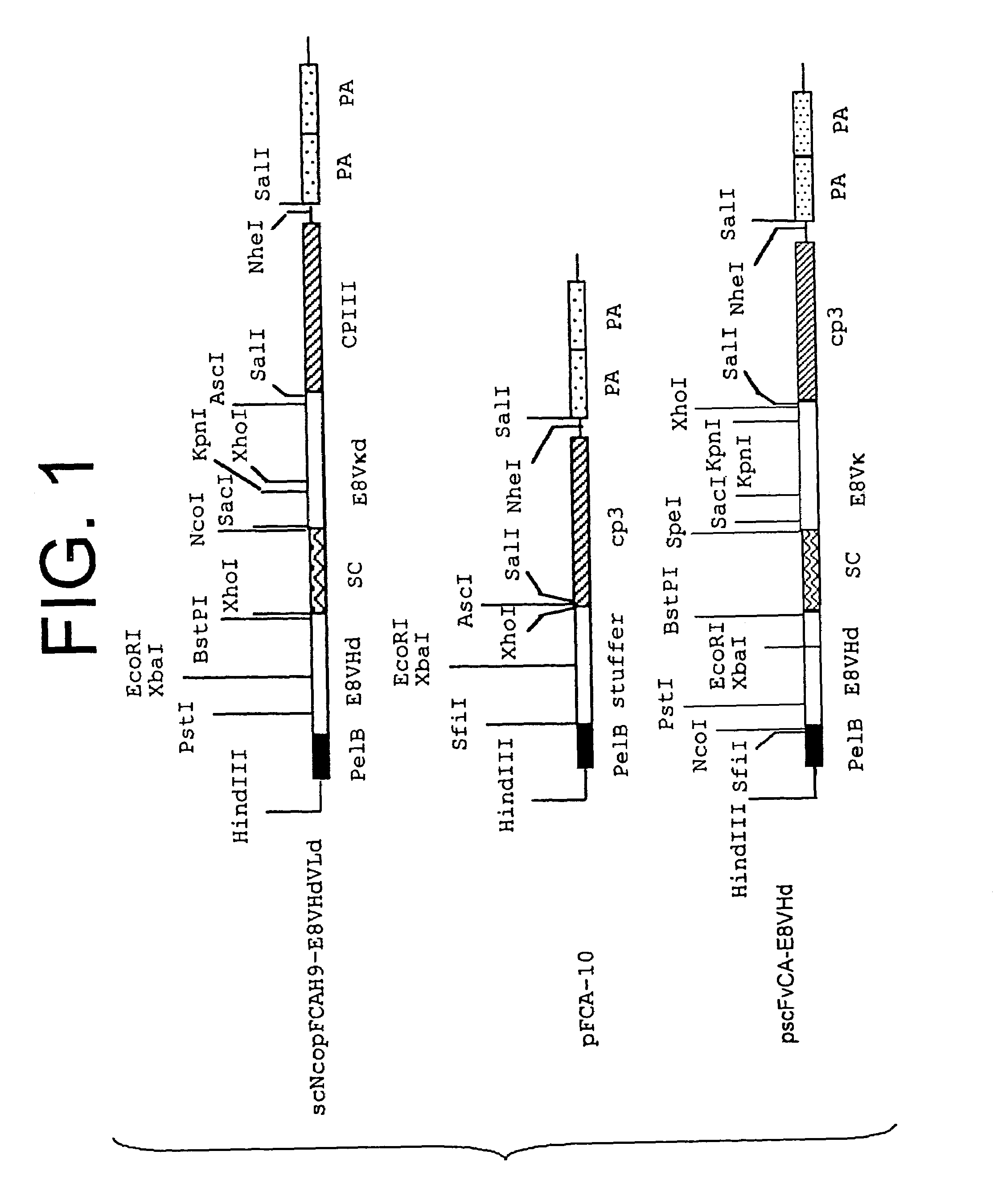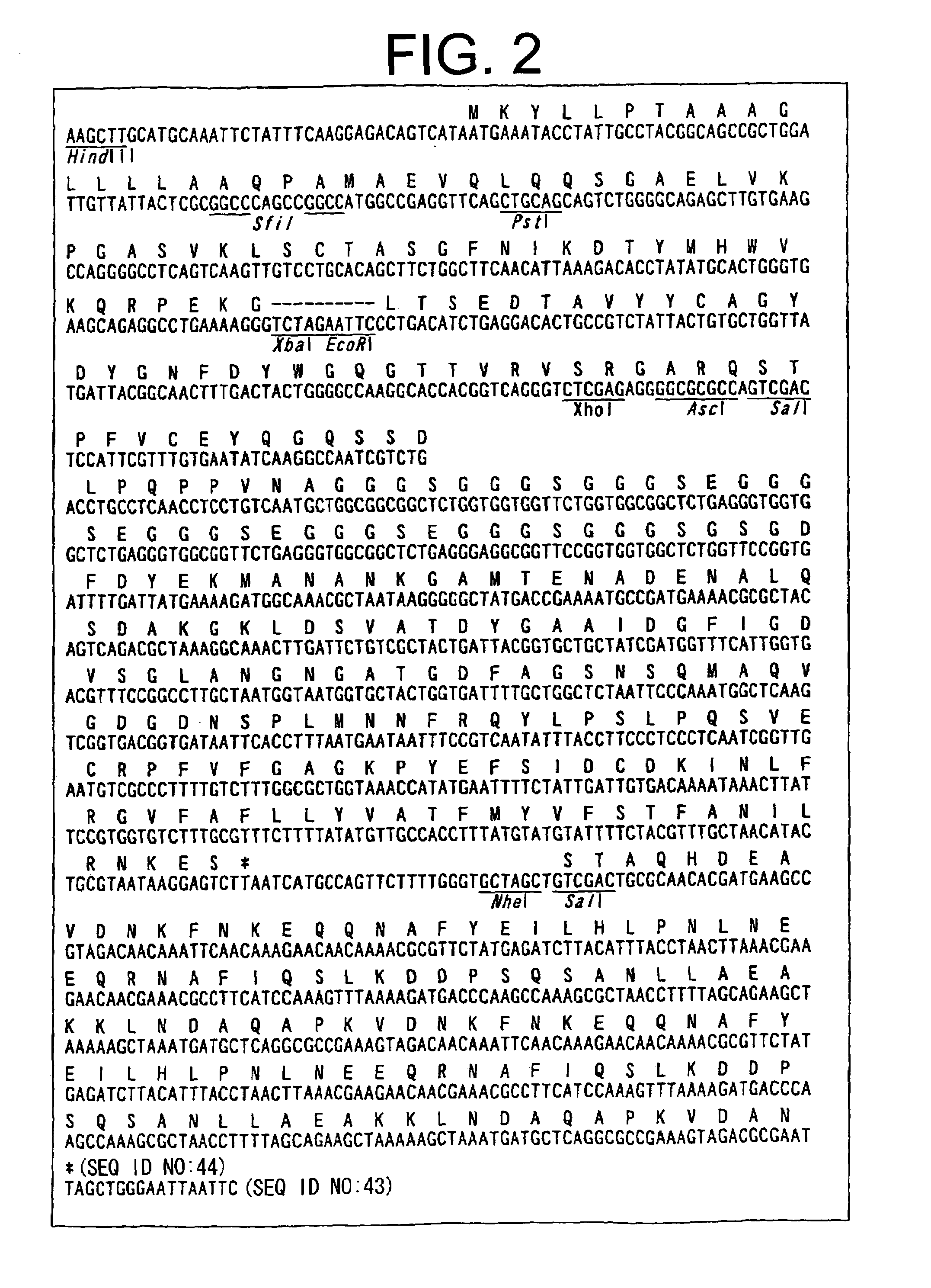Methods of constructing camel antibody libraries
a camel antibody and library technology, applied in the field of methods of constructing camel antibody libraries, can solve the problems of non-specific antibodies, large amount of antigen purification, and inability to bind well to the antigen binding site of antibodies, so as to avoid the effect of reducing the amount of antigens, enhancing enzyme activity, and inhibiting enzyme activity
- Summary
- Abstract
- Description
- Claims
- Application Information
AI Technical Summary
Benefits of technology
Problems solved by technology
Method used
Image
Examples
example 1
Construction of Camel Antibody Library
1-1. Confirmation of Restriction Enzyme Sites in Camel Germline and Primer Designing
[0205]In the following Examples, New England biolabs or buffers produced by this company will be indicated as NEB. The absence of sites cleavable with SfiI or AscI restriction enzyme used for subcloning into a vector was confirmed in the germlines of camel VH or VHH by referring to a reference (Nguyen et al., EMBO J. 19(5), 921 (2000)). Six kinds of primers for the N-terminus of the V region covering the germlines of VH and VHH were constructed. The nucleotide sequences of the primers are shown in SEQ ID NOs: 1 to 6.
[0206]
(1) VHH3a (SEQ ID NO: 1)GTCCTCGCAACT GCG GCC CAG CCG GCC ATG GCC GAG GTGCAG CTG GTG GAG TGT GG(2) VHH-germF1 (SEQ ID NO: 2)GTCCTCGCAACT GCG GCC CAG CCG GCC ATG GCC CAG GTRCAG CTG GTG GAG TCT GG(3) VHH-germF2 (SEQ ID NO: 3)GTCCTCGCAACT GCG GCC CAG CCG GCC ATG GCC CAG GTAAAG CTG GAG GAG TCT GG(4) VHH-germF4 (SEQ ID NO: 4)GTCCTCGCAACT GCG GCC CAG C...
example 2
Analysis of VHH Genes
[0274]In Example 1, oligonucleotides comprising the nucleotide sequences of following SEQ ID NOs were used as primers. The origin of VHH amplified by each of the combinations of primers is summarized below.
[0275]
5′-side (N-terminal)3′-side (C-terminal)origin of amplified VHHSEQ ID NOs: 1-6SEQ ID NO: 10IgG2SEQ ID NOs: 1-6SEQ ID NO: 11IgG3
[0276]Fifty or more clones were randomly selected from each library to analyze their nucleotide sequences. Examples of analyzed results are shown in Table 1. Each cell of the Table corresponds to a single class. In Table 1, subfamilies are classified based on the position of cysteine residues, and furthermore, within the subfamilies, classes are grouped based on the length of CDR2 and CDR1. The determination of CDR was performed according to a known method (Kabat et al., Sequence of Proteins of Immunological Interest, 5th edit., US Public Health Service, NIH Bethesda, Md., Publication (1991) No. 91-3242). Structural characteristi...
example 3
Production of VHHs Against GST Using VHH-Type Antibody Libraries
3-1. Determination of Screening Conditions
[0292]Based on the screening method of WO 01 / 62907, VHHs having binding affinity for glutathione S-transferase (GST) were selected.
[0293]GST was prepared to a final concentration of 0.1 mg / mL using PBS, 3.8 mL of this solution was placed into each of 1 (first time) or 2 (second and third time) test tubes (Nunc, MaxiSorp™), and incubated at 4° C. for 18 hr to adsorb GST on the inner wall of the test tubes. After adsorption, the solution was discarded, 3.8 mL of PBS containing 2% skim milk was added to each tube, and reacted at 25° C. for 1 hr for blocking.
[0294]IgG2 and IgG3 libraries were screened independently without mixing. The amount of phage used is shown under the column of “Input phage (cfu)” in Table 3. 3.8 ml of phage solution suspended in PBS containing 2% skim milk was added to each test tube, and after reacting at room temperature for 2 hr, the test tubes were washed...
PUM
| Property | Measurement | Unit |
|---|---|---|
| Fraction | aaaaa | aaaaa |
| Molar density | aaaaa | aaaaa |
| Molar density | aaaaa | aaaaa |
Abstract
Description
Claims
Application Information
 Login to View More
Login to View More - R&D
- Intellectual Property
- Life Sciences
- Materials
- Tech Scout
- Unparalleled Data Quality
- Higher Quality Content
- 60% Fewer Hallucinations
Browse by: Latest US Patents, China's latest patents, Technical Efficacy Thesaurus, Application Domain, Technology Topic, Popular Technical Reports.
© 2025 PatSnap. All rights reserved.Legal|Privacy policy|Modern Slavery Act Transparency Statement|Sitemap|About US| Contact US: help@patsnap.com



